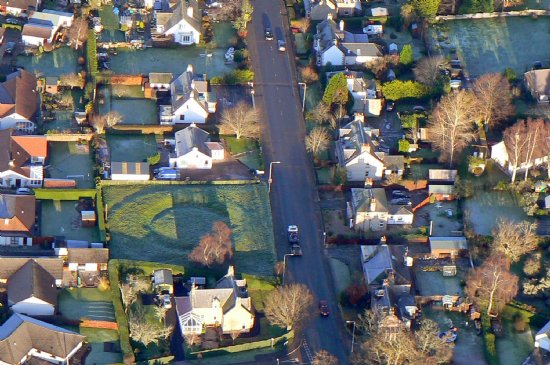Pullyhour Henge
04 March 2019
- News Type:
- Site of the Month

Pullyhour henge is located on the side of a valley, overlooking the Thurso river, Caithness. It survives as a well preserved earthwork, comprising an extant external bank and internal ditch with a small oval interior. A single entrance is situated to the south-west, and it is aligned on the remains of a large cairn (Leosag Cairn) on the opposite bank of the river. It is one of a number of smaller earthwork monuments in the north and northeast of Scotland described as ‘henges’ or ‘hengiforms’ and it was partially excavated in the Spring of 2008 by Richard Bradley of the University of Reading, as part of planned research designed to investigate and date one of these monument from the north of Scotland.
These excavations discovered that the henge was built in two phases. In the first, it was circular, with a broad and shallow ditch, 3m wide and c. 0.5m deep, with an entrance 1.25m wide to the south, which would have held water. Surrounding the ditch was an external bank, c. 2m wide and c.0.5m high, which had a narrow entrance only 0.4m wide. The area enclosed in the centre was 7m in diameter and no archaeological features were discovered within it. Charcoal from the buried soil beneath the bank was radiocarbon dated to 1620-1460 BC, calibrated to 2 sigma, indicating construction of the monument to be no earlier than this.
The second phase of use occurred after a period of inactivity, as indicated by the development of a soil horizon over the original bank. Charcoal from this layer was dated to 1369-1126 BC, calibrated to 2 sigma. After this date, the ditch, bank, interior and entrance underwent remodelling; the exterior bank was enlarged, and the ditch was recut inside on the E and W side altering the enclosed area to an oval shape 7m by 6m. A horseshoe shaped bank was also constructed in the interior, only 0.5m wide and 0.1m high, further reducing the enclosed area which was cobbled with small fragments of white sandstone. A small post hole as discovered in the centre of this enclosure, and two others were located outside the entrance of the henge. The larger of these, which cut through the primary bank and thus is of later date, was c. 1m in diameter and 0.6m in depth, and contained the stump of a post. This was identified as pine, a species which had become extinct in Caithness at the end of the Neolithic period. It was radiocarbon dated to 2573-2348 BC, calibrated to 2 sigma, indicating that it must have been extracted from a bog and was a relic of some antiquity when erected and likely chosen for this reason.
Due to the lack of internal features, little was discovered about the use of the henge. The only observations that could be made were that the interior would have been clearly visible from the outside, and so any activity within the enclosure was not made to be concealed, and the small size of the interior and single, narrow entrance meant that it could not have involved large number of people. The lack of archaeological traces within the interior, and absence of wear to the entrances may indicate that the use of the monument was brief or sporadic. The closing of the monument was likely to have been a significant event, involving the removal of the post alignment and symbolic blocking of the entrance.

There are currently 29 possible henge sites recorded in the Highland HER, and Pullyhour is one of only three, smaller, hengiform type monuments that have seen investigation within recent years in northern Scotland. Thus, along with these others at Lairg and Loch Migdale (MHG10021), it is an important site because it is one of the few excavated examples representative of this group of monuments. Its significance is further increased in light of the radiocarbon dates obtained from the site; henges have generally been regarded as Neolithic monuments, however, Pullyhour, and also Lairg, have both returned Bronze Age dates. This has interesting implications for the dating of this group of monuments. Other well preserved henges survive in Easter Ross, at Achilty (MHG7792), Conon Bridge (MHG9059) and Culbokie (MHG9064). Will future work at any of these sites prove them to be of Bronze Age date too?
Further Information
HER MHG1368
Canmore ID: 8366 (https://canmore.org.uk/site/8366)
Bradley, R and Lamdin-Whymark, H. 2008. The excavation of a small henge monument at Pullyhour, Halkirk, Caithness: interim report. University of Reading.
Bradley, R. 2011. Stages and Screens, An investigation of four henge monuments in northern and north-eastern Scotland. Society of Antiquaries of Scotland Monograph Series. pp. 118-141.
https://nosasblog.wordpress.com/2014/11/17/highland-henge-trail/
Woodham, A A, 1955, 'Four henge monuments in Easter Ross', Proceedings of the Society of Antiquaries Scotland 87, 72-9 (Available online or Inverness Library)
Report supplied by Grace Woolmer
Site of the Month Archive
- 10/04/2021 Easter Raitts township
- 02/03/2021 Lower Slackbuie, Inverness (ASDA) Neolithic site
- 01/02/2021 Balnuaran of Clava cairns
- 04/01/2021 Wilkhouse Inn
- 02/12/2020 Spinningdale Cotton Mill
- 02/11/2020 Skibo A Canadian Forestry Camp
- 01/10/2020 WWI Detonator Store, Dalmore near Invergordon
- 03/09/2020 Mesolithic Shell Midden at Sand, Wester Ross
- 08/08/2020 Kinbeachie Neolithic settlement
- 01/07/2020 Armadale Cist Burial and Stone & Timber Complex
